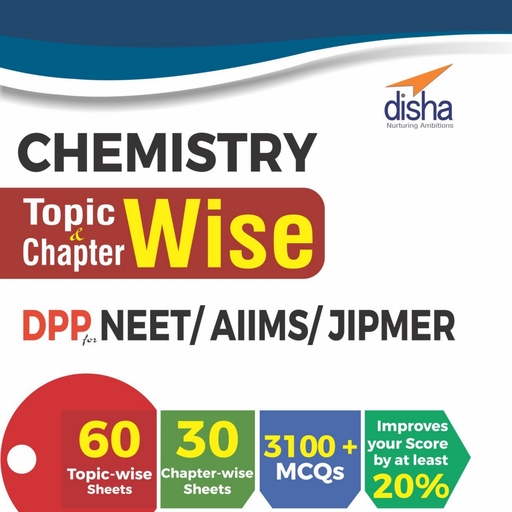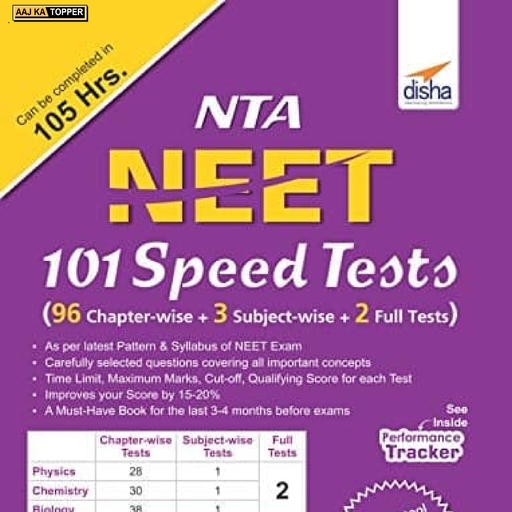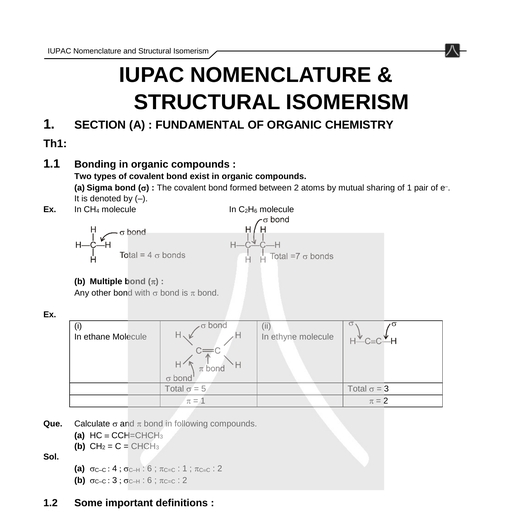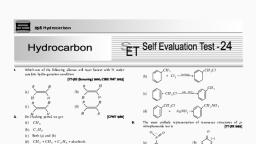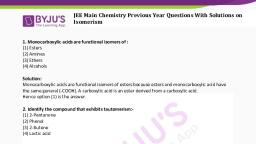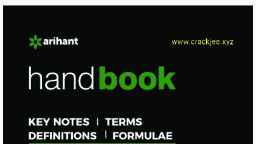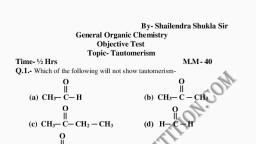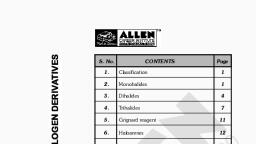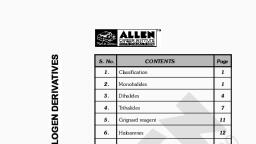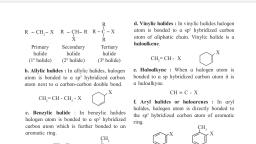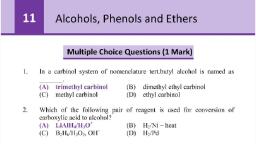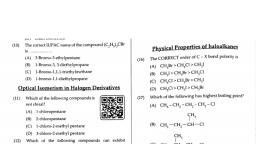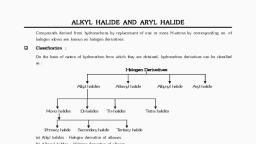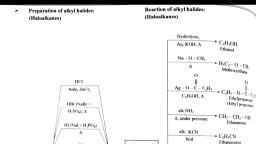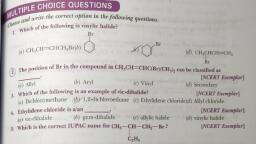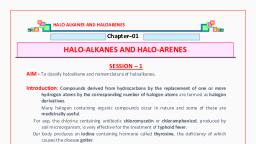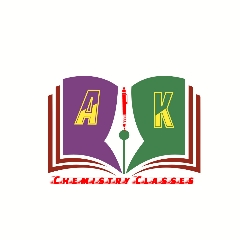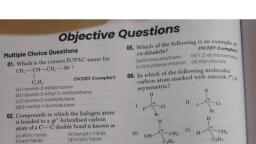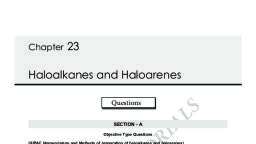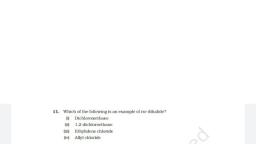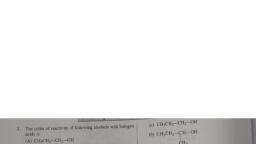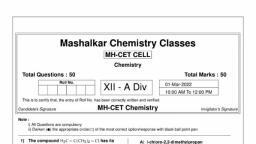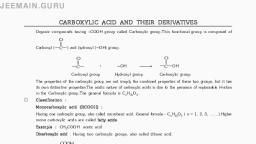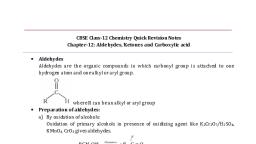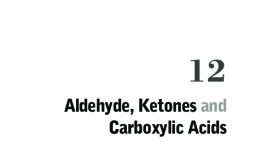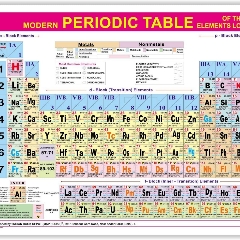Page 1 :
1170 Halogen Containing Compounds, (c) 2, 3, 4-trimethylpentane, (d) 3, 3-dimethylpentane, , Preparation of Halogen containing compounds, 1., , Introduction of Halogen containing compounds, , The following reaction is known as, Pyridine, C 2 H 5 OH SOCl 2 , C 2 H 5 Cl SO 2 HCl, , [AIIMS 2002], , 1., , 2., , 3., , How many structural isomers are possible for a compound with, molecular formula C 3 H 7 Cl, [MH CET 2001], (a) 2, (c) 7, In CH 3 CH 2 Br, % of Br is, , CH 2 (Br)CH 2 CH 2, , (d), , CH 2 BrCH 2 Br, , Ethylidene dibromide is, (a) CH 3 CH 2 Br, , (b), , Br CH 2 CH 2 Br, , (d), , CH 2 CBr2, , (c), 5., , 6., , 7., , 8., , 9., , 10., , 12., , 13., , CH 3 CHBr2, , 2., , (b), , C 6 H 5 CHCl 2, , (c), , (d), , C 6 H 5 CCl 3, , C 6 H 4 ClCH 2 Cl, , Which of the following halide is 2 o, (a) Isopropyl chloride, (b) Isobutyl chloride, (c) n-propyl chloride, (d) n-butyl chloride, Haloforms are trihalogen derivatives of, [CPMT 1985], (a) Ethane, (b) Methane, (c) Propane, (d) Benzene, Benzene hexachloride is, (a) 1, 2, 3, 4, 5, 6-hexachlorocyclohexane, (b) 1, 1, 1, 6, 6, 6-hexachlorocyclohexane, (c) 1, 6-phenyl-1, 6-chlorohexane, (d) 1, 1-phenyl-6, 6-chlorohexane, Number of bonds present in B.H.C. (Benzene hexachloride), are, [RPMT 1999], (a) 6, (b) Zero, (c) 3, (d) 12, The general formula for alkyl halides is, (a) C n H 2n 1 X, (b) C n H 2n 2 X, C n H n 1 X, , 3., , , , N NBF4, , 4., , , , A, , Benzylidene chloride is, (a) C 6 H 5 CH 2 Cl, , (c), 11., , [DPMT 1996], , (a) 80, (b) 75, (c) 70, (d) 7, Gem- dibromide is, [RPMT 2000], (a) CH 3 CH (Br)OH(Br)CH 3 (b) CH 3 CBr2 CH 3, (c), , 4., , (b) 5, (d) 9, , (a) Kharasch effect, (b) Darzen’s procedure, (c) Williamson’s synthesis, (d) Hunsdiecker synthesis reaction, What is the main product of the reaction between 2-methyl propene, with HBr, [RPMT 2002], (a) 1-bromo butane, (b) 1-bromo-2 methyl propane, (c) 2-bromo butane, (d) 2-bromo-2 methyl propane, Halogenation of alkanes is, [KCET 2002], (a) A reductive process, (b) An oxidative process, (c) An isothermal process, (d) An indothermal process, , (d), , In the above process product A is, [Kerala (Engg.) 2002], (a) Fluorobenzene, (b) Benzene, (c) 1, 4-difluorobenzene, (d) 1, 3-difluorobenzene, 5., , [Kurukshetra CET 2002], , The compound which contains all the four 1 o ,2 o ,3 o and 4 o, carbon atoms is, [J & K 2005], (a) 2, 3-dimethyl pentane, (b) 3-chloro-2, 3-dimethylpentane, , (a), , CH 3 Br, , (b) CH 3 COI, , (c), , CH 3 COOH, , (d) None of these, , Cl, 6., , 7., , Diazonium salts Cu 2 Cl 2 HCl , , , the reaction is, , known as, [Kerala (Med.) 2002], (a) Chlorination, (b) Sandmeyer’s reaction, (c) Perkin reaction, (d) Substitution reaction, When ethyl alcohol (C 2 H 5 OH ) reacts with thionyl chloride, in the, presence of pyridine, the product obtained is, [AIIMS; CBSE PMT 2001], , (a), , C n H 2n X, , Which of the following is a primary halide, [DCE 2004], (a) Isopropyl iodide, (b) Secondary butyl iodide, (c) Tertiary butyl bromide, (d) Neo hexyl chloride, Full name of DDT is, [KCET 1993], (a) 1, 1, 1-trichloro-2, 2-bis(p-chlorophenyl) ethane, (b) 1, 1-dichloro-2, 2-diphenyl trimethylethane, (c) 1, 1-dichloro-2, 2-diphenyl trichloroethane, (d) None of these, , CS 2, Silver acetate Br2 , . The main product of this reaction is, , CH 3 CH 2 Cl HCl, , (b) C 2 H 5 Cl HCl SO 2, (c), , CH 3 CH 2 Cl H 2 O SO 2, , (d) CH 3 CH 2 Cl HCl SO 2, 8., , 9., , Preparation of alkyl halides in laboratory is least preferred by[DPMT 2000], (a) Treatment of alcohols, (b) Addition of hydrogen halides to alkenes, (c) Halide exchange, (d) Direct halogenation of alkanes, Which of the following organic compounds will give a mixture of, 1-chlorobutane and 2-chlorobutane on chlorination, [CPMT 2001]
Page 2 :
Halogen Containing Compounds 1171, (a), , CH 3 CH CH CH 2, , 20., , |, , CH 3, , H, |, , (b), , 10., , HC C C CH 2, 21., , (c), , CH 2 CH CH CH 2, , (d), , CH 2 CH CH 2 CH 3, , The chlorobenzene is generally obtained from a corresponding, diazonium salt by reacting it with, [MP PMT 2000], , 11., , (a), , Cu 2 Cl 2, , (b), , CuSO 4, , (c), , Cu, , (d), , Cu (NH 3 )42 , , Decreasing order of reactivity, ROH HX RX H 2 O, , of HX in, , the, , reaction, , 12., , 13., , HI HBr HCl HF (b), , 23., , (a), , CH 3 CH (Br) CCl 3, , (c), , BrCH 2 CHCl CHCl 2 (d) CH 3 CH 2 CCl 3, , (b), , CH 2 (Br) CH 2 CCl 3, , Chlorobenzene is prepared commercially by, , CH 3 CHO, , (b) CCl 3 CHO, , (c), , CHCl 3, , (d) (CH 3 ) 2 O, , When ethyl alcohol and KI reacted in presence of Na 2 CO 3 , yellow, crystals of...... are formed, [AFMC 1989], (a) CHI 3, (b) CH 3 I, CH 2 I 2, , 24., , (a) Hydrolysis, (b) Oxidation, (c) Reduction, (d) Chlorination, Which of the following is obtained when chloral is boiled with, , NaOH, (a), 25., 26., , CH 3 Cl, , (a) The ion formed initially may react with Br or CH 3 OH, , 15., , 28., , (c), 17., , CHCl CHCl, , (d), , 19., , 29., , 30., , Which compound does not form iodoform with alkali and iodine[IIT-JEE 1985], (a) Acetone, (b) Ethanol, (c) Diethyl ketone, (d) Isopropyl alcohol, Which compound gives yellow ppt. with iodine and alkali, , 31., , (a) 2-hydroxy propane, (b) Acetophenone, (c) Methyl acetone, (d) Acetamide, Acetone reacts with I 2 in presence of NaOH to form, , [IIT-JEE 1984], , Tertiary > Secondary > Primary, Tertiary < Secondary < Primary, Tertiary < Secondary > Primary, Secondary < Primary < Tertiary, CCl 3 CHO, , (b), , [MP PMT 1996; MP PET 1992, 95;, CPMT 1986, 89; AIIMS 1980; Kurukshetra CEE 2002], , (d) Concentrated HCl anhydrous MgCl2, , [MP PMT 1992], , (a), , UV Light, 32., C 6 H 6 Cl 2 , Product. In above reaction product is [CPMT 1997], , (a), , (b) Iodoform, (d) Methyl iodide, , CH 2 CHCl, , [CPMT 1997], , 18., , (a) Ethanol, (c) Ethyl iodide, Lucas reagent is, , (c) Concentrated HNO 3 anhydrous ZnCl 2, , R OH HX R X H 2 O, In the above reaction, the reactivity of different alcohols is, , (a), (b), (c), (d), , [IIT-JEE 1983; MP PET 1990; EAMCET 1990;, AFMC 1993; JIPMER 2001], , (b) Dilute HCl hydrated ZnCl 2, , [AFMC 1997; CPMT 1999], , 16., , (a) Ethyl chloride, (b) Chloroform, (c) Acetaldehyde, (d) Chloral, On heating diethyl ether with conc. HI, 2 moles of which of the, following is formed, , (a) Concentrated HCl anhydrous ZnCl 2, , Light, C3 H 8 Cl 2 , C3 H7 Cl HCl is an example of which of, the following types of reactions, , (a) Substitution, (b) Elimination, (c) Addition, (d) Rearrangement, Which of the following would be produced when acetylene reacts, with HCl, [MH CET 1999], (a) CH 3 CH 2 Cl, (b) CH 3 CHCl 2, , [MNR 1986], , [MP PMT 1989; CPMT 1997; KCET 1998; JIPMER 1999], , (a) Raschig process, (b) Wurtz Fitting reaction, (c) Friedel-Craft’s reaction, (d) Grignard reaction, 27., In methyl alcohol solution, bromine reacts with ethylene to yield, BrCH 2 CH 2 OCH 3 in addition to 1, 2-dibromoethane because[Pb. PMT 1998], (b) The methyl alcohol solvates the bromine, (c) The reaction follows Markownikoff's rule, (d) This is a free-radical mechanism, , [CBSE PMT 1991; RPMT 1999], , (b) CHCl 3, , (c) CCl 4, (d) None of these, Chloroform can be obtained from, (a) Methanol, (b) Methanal, (c) Propanol-1, (d) Propanol-2, Chlorine reacts with ethanol to give, , [JIPMER 2000; CPMT 1976; Pb. CET 2002], , 14., , (d) C 2 H 5 I, , In preparation of CHCl 3 from ethanol and bleaching powder, the, latter provides, [BHU 1986], (a) Ca(OH ) 2, (b) Cl 2, (c) Both (a) and (b), (d) None of these, Which one of the following processes does not occur during, formation of CHCl 3 from C 2 H 5 OH and bleaching powder, [DPMT 1984], , HBr HCl HI HF, , (c) HCl HBr HI HF (d) HF HBr HCl HI, The product of the following reaction :, [RPET 2000], CH 2 CH CCl 3 HBr, , (a), , (c), 22., , [RPET 2000; AIIMS 1983; MP PET 1996], , (a), , (c) Bright sunlight, (d) Zinc, The final product obtained by distilling ethyl alcohol with the excess, of chlorine and Ca(OH ) 2 is, [MP PET 1996], , C 6 H 6 Cl 6, , (c) C 6 H 12 Cl 6, (d) C 6 H 9 Cl 2, Benzene reacts with chlorine to form benzene hexachloride in, presence of, [MP PET 1999], (a) Nickel, (b) AlCl3, , 33., , C2 H 5 I, , (b) C 2 H 4 I 2, , (c) CHI 3, (d) CH 3 I, Ethanol is converted into ethyl chloride by reacting with, [MP PET 1991; MP PMT 1990; BHU 1997], , (a) Cl 2, (b) SOCl 2, (c) HCl, (d) NaCl, C 6 H 5 Cl prepared by aniline with, (a) HCl, , [IIT-JEE 1984]
Page 3 :
1172 Halogen Containing Compounds, , 34., , 47., , (b), , Cu 2 Cl 2, , (c), , Cl 2 in presence of anhydrous AlCl3, , (d), , HNO 2 and then heated with Cu 2 Cl 2, , [KCET 2004; EAMCET 1986], , The starting substance for the preparation of CH 3 I is, [CPMT 1975], , (a), , CH 3 OH, , (b), , Which of the following compounds gives trichloromethane on, distilling with bleaching powder, , 48., , C 2 H 5 OH, , (a) Methanal, (b) Phenol, (c) Ethanol, (d) Methanol, The product formed on reaction of ethyl alcohol with bleaching powder, is, [Orissa JEE 2004; DPMT 1978; AIIMS 1991], (a) CHCl 3, (b) CCl 3 CHO, , (c), 35., , 36., , 37., , 38., , 39., , 40., , (d) (CH 3 )2 CO, CH 3 CHO, (c) CH 3 COCH 3, (d) CH 3 CHO, A Grignard's reagent may be made by reacting magnesium with [CPMT 1973,, 49.83, 84]Ethylene reacts with bromine to form, [Pb. CET 2000], (a) Methyl amine, (b) Diethyl ether, (a) Chloroethane, (b) Ethylene dibromide, (c) Ethyl iodide, (d) Ethyl alcohol, (c) Cyclohexane, (d) 1-bromo propane, 50., Best method of preparing alkyl chloride is, [MH CET 2004], Which of the following is responsible for iodoform reaction, [CPMT 1980; RPMT 1997], (a) ROH SOCl 2 , (a) Formalin, (b) Methanol, (b) ROH PCl5 , , (c) Acetic acid, (d) Ethanol, When a solution of sodium chloride containing ethyl alcohol is, (c) ROH PCl3 , , electrolysed, it forms, anhy. ZnCl 2, (d) ROH HCl , (a) Ethyl alcohol, (b) Chloral, 51., DDT is prepared by reacting chlorobenzene with, (c) Chloroform, (d) Acetaldehyde, [BHU 1998, 2005], Which reagent cannot be used to prepare an alkyl halide from an, (a) CCl 4, (b) CCl 3 CHO, alcohol, [CPMT 1989, 94], (a), , HCl ZnCl2, , (b) NaCl, , (c), , PCl5, , (d), , 52., , SOCl 3, , [Pb. PET 2003], , Ethyl benzoate reacts with PCl5 to give, (a), , C 2 H 5 Cl C6 H 5 COCl POCl3 HCl, , (b), , C 2 H 5 Cl C6 H 5 COCl POCl3, , (c), , CH 3 COCl C6 H 5 COCl POCl3, , (d), , C 2 H 5 Cl C6 H 5 COOH POCl3, , (c) CHCl 3, (d) Ethane, Which compound needs chloral in its synthesis, , [KCET 2003], , 53., , 54., , (a) D. D. T., (b) Gammexane, (c) Chloroform, (d) Michler’s Ketone, To get DDT, chlorobenzene has to react with which of the following, compounds in the presence of concentrated sulphuric acid [KCET (Engg/Med.) 20, (a) Trichloroethane, (b) Dichloroacetone, (c) Dichloroacetaldehyde, (d) Trichloroacetaldehyde, What will be the product in the following reaction, , CH, , On treatment with chlorine in presence of sunlight, toluene giv.es, the product, [Orissa JEE 2003; MH CET 1999, 2002], , 41., , 42., , CH, , 44., , 45., , [AFMC 2004], , (a) Chloroform, (c) Ethanol, , (b) Acetaldehyde, (d) Phosgene, , 3, , Br, , CH, , 3, , 2, , (c), , (d), , Br, , Properties of Halogen containing compounds, CCl, , 3, , 1 eqv. of Br2 / Fe, , A. Compounds A is, , 1., , [Orissa JEE 2005], , CCl, , CCl, , 3, , 3, , (a), , Br, , (b), , Br, CCl, , CCl, , 3, , 3, , [AIEEE 2004], , 46., , CH, (b), , CH Br, , (c) Sunlight, (d) Ethanol Na, The compound formed on heating chlorobenzene with chloral in the, presence of concentrated sulphuric acid, is, (a) Freon, (b) DDT, (c) Gammexene, (d) Hexachloroethane, Acetone is mixed with bleaching powder to give, , [BHU 2005], , 3, , (a), , [MP PET 2003], , 43., , NBS, , Br, , (a) o-chloro toluene, (b) 2, 5-dichloro toluene, (c) p-chloro toluene, (d) Benzyl chloride, When chlorine is passed through warm benzene in presence of the, sunlight, the product obtained is, [KCET 2003], (a) Benzotrichloride, (b) Chlorobenzene, (c) Gammexane, (d) DDT, Which of the following acids adds to propene in the presence of, peroxide to give anti-Markownikoff’s product, (a) HF, (b) HCl, (c) HBr, (d) HI, Propene on treatment with HBr gives, [CPMT 1986], (a) Isopropyl bromide, (b) Propyl bromide, (c) 1, 2-dibromoethane, (d) None of the above, The catalyst used in Raschig's process is, (a) LiAlH4, (b) Copper chloride, , 2, , (c), , Br, 2., , (d), , Br, Br, , Ethyl bromide can be converted into ethyl alcohol by, [KCET 1989], , (a) Heating with dilute hydrochloric acid and zinc
Page 4 :
Halogen Containing Compounds 1173, , 3., , (b) Boiling with an alcoholic solution of KOH, (c) The action of moist silver oxide, (d) Refluxing methanol, Reaction of ethyl chloride with sodium leads to, , 14., [NCERT 1984], , 4., , (a) Ethane, (b) Propane, (c) n-butane, (d) n-pentane, Treatment of ammonia with excess of ethyl chloride will yield[AIIMS 1992], 15., (a) Diethyl amine, (b) Ethane, (c) Tetraethyl ammonium chloride, (d) Methyl amine, , 5., , 2CHCl 3 O 2 2COCl 2 2 HCl, , 6., , In the above reaction, X stands for, [CPMT 1985], (a) An oxidant, (b) A reductant, (c) Light and air, (d) None of these, Phosgene is the common name for, , X, , 16., , 17., , [DPMT 1983; CPMT 1993; MP PMT 1994;, Kurukshetra CEE 1998; RPMT 2000, 02], , (a), 7., , CO 2 and PH 3, , (b) Phosphoryl chloride, , (c) Carbonyl chloride, (d) Carbon tetrachloride, When chloroform is treated with amine and KOH, we get, , 18., , (c) Nearly as reactive as methyl chloride, (d) More reactive than isopropyl chloride, The reactivities of methyl chloride, propyl chloride and, chlorobenzene are in the order, [KCET 1988], (a) Methyl chloride > propyl chloride > chlorobenzene, (b) Propyl chloride > methyl chloride > chlorobenzene, (c) Methyl chloride > chlorobenzene > propyl chloride, (d) Chlorobenzene > propyl chloride > methyl chloride, Which of the following compound will make precipitate most readily, with AgNO 3, [CPMT 1992], (a), , CCl 3 CHO, , (b) CHCl 3, , (c), , C 6 H 5 CH 2 Cl, , (d) CHI 3, , Carbylamine is liberated when..... is heated with chloroform and, alcoholic potash, [KCET 1992], (a) An aldehyde, (b) A primary amine, (c) A secondary amine, (d) A phenol, Salicylic acid can be prepared using Reimer-Tiemann's reaction by, treating phenol with, [KCET 1989], (a) Methyl chloride in the presence of anhydrous aluminium chloride, (b) Carbon dioxide under pressure in sodium hydroxide solution, (c) Carbon tetrachloride and concentrated sodium hydroxide, (d) Sodium nitrite and a few drops of concentrated sulphuric acid, Grignard reagent is prepared by the reaction between, [CBSE PMT 1994; DPMT 1996; Pb. PMT 1999;, MH CET 1999], , [CPMT 1979], , 8., , 9., , (a) Rose odour smell, (b) Sour almond like smell, (c) Offensive odour, (d) Sour oil of winter green like smell, A mixture of two organic chlorine compounds was treated with, sodium metal in ether solution. Isobutane was obtained as a product., The two chlorine compounds are, [KCET 1988], (a) Methyl chloride and propyl chloride, (b) Methyl chloride and ethyl chloride, (c) Isopropyl chloride and methyl chloride, (d) Isopropyl chloride and ethyl chloride, Alkyl halides can be converted into Grignard reagents by, , 19., , 20., , 21., , [EAMCET 1987; CBSE PMT 1988; MP PET 2000], , (a), , [KCET 1989], , 22., , (d) Warming them with MgCl2, 10., , 23., , (a) Salicylaldehyde, (b) Phenolphthalein, (c) Salicylic acid, (d) Cyclohexanol, C 6 H 5 CH 2 Cl KCN (aq.) X Y, Compounds X and Y are, [BHU 1979], (a) C 6 H 6 KCl, (b) C 6 H 5 CH 2 CN KCl, , 24., , (c) C 6 H 5 CH 3 KCl, (d) None of these, The bad smelling substance formed by the action of alcoholic caustic, potash on chloroform and aniline is, , [CBSE PMT 1991], , 11., , 12., , 13., , (c) CCl 4 will dissolve in AgNO 3, (d) Nothing will happen, If we use pyrene (CCl 4 ) in the Riemer-Tiemann reaction in place, of chloroform, the product formed is, [CBSE PMT 1989; MP PMT 1990; MH CET 1999], , Which is not present in Grignard reagent, (a) Methyl group, , NO 2 will be evolved, , (b) A white ppt. of AgCl will be formed, , (a) Boiling them with Mg ribbon in alcoholic solution, (b) Warming them with magnesium powder in dry ether, (c) Refluxing them with MgCl2 solution, , (a) Zinc and alkyl halide, (b) Magnesium and alkyl halide, (c) Magnesium and alkane, (d) Magnesium and aromatic hydrocarbon, Reaction of t-butyl bromide with sodium methoxide produces[CBSE PMT 1994], (a) Isobutane, (b) Isobutylene, (c) Sodium t-butoxide, (d) t-butyl methyl ether, War gas is formed from, [BHU 1995], (a) PH 3, (b) C 2 H 2, (c) Zinc phosphate, (d) Chloropicrin, What happens when CCl 4 is treated with AgNO 3, , (b) Magnesium, , (c) Halogen, (d) COOH group, The reactivity of ethyl chloride is, [KCET 1986], (a) More or less equal to that of benzyl chloride, (b) More than that of benzyl chloride, (c) More or less equal to that of chlorobenzene, (d) Less than that of chlorobenzene, The reactivity of halogen atom is minimum in, [KCET 1985], (a) Propyl chloride, (b) Propyl iodide, (c) Isopropyl chloride, (d) Isopropyl bromide, Chlorobenzene is, (a) Less reactive than benzyl chloride, (b) More reactive than ethyl bromide, , [MP PMT 1971, 92, 2001; CPMT 1971, 86; AFMC 2002;, RPMT 1999], , 25., , (a) Phenyl isocyanide, (b) Nitrobenzene, (c) Phenyl cyanide, (d) Phenyl isocyanate, Ethylidene chloride on treatment with aqueous KOH gives, [MP PMT 1986], , (a) Ethylene glycol, (c) Formaldehyde, , (b) Acetaldehyde, (d) None
Page 5 :
1174 Halogen Containing Compounds, 26., , Reaction C 2 H 5 I C 5 H 11 I 2 Na C 2 H 5 C 5 H 11 2 NaI, is called, [MP PMT 1992], , 27., , 28., , 29., , 30., , (a) Hoffmann's reaction, (b) Dow's reaction, (c) Wurtz's reaction, (d) Riemer-Tiemann's reaction, In presence of AlCl3 , benzene and n-propyl bromide react in, Friedal-Craft's reaction to form, [MP PMT 1991], (a) n-propyl benzene, (b) 1, 2-dinormal propyl benzene, (c) 1, 4-dinormal propyl benzene, (d) Isopropyl benzene, The, dehydrobromination, of, 2-bromobutane, gives, CH 3 CH CHCH 3 . The product is, (a) Hofmann product, (b) Saytzeff product, (c) Hoffmann-Saytzeff product, (d) Markownikoff product, Ethylene difluoride on hydrolysis gives, (a) Glycol, (b) Fluoroethanol, (c) Difluoroethanol, (d) Freon, Benzyl chloride when oxidised by pb(NO 3 ) 2 gives, , (c), 38., , 39., , 31., , 32., , (a) It is a colourless, sweet-smelling liquid, (b) It is almost insoluble in water, (c) It is highly inflammable, (d) It can be used as an inhalational anaesthetic agent, CCl 4 cannot give precipitate with AgNO 3 due to, , [Manipal MEE 1995], , CH 3 CH 2 CH 2 Br KOH (alc.) Product Product in, above reaction is, [RPMT 2003], (a) CH 3 CH CH 2, (b) CH 3 CH 2 CH 3, , (c) (a) and (b) both, (d) None of these, A CCl 4 KOH Salicylic acid, , (a), , (c), 40., , 37., , (d), , Identify X and Y in the following sequence, X, Y, C2 H 5 Br , product , C3 H 7 NH 2, , [Orissa JEE 2005], , (a), , X KCN , Y LiAlH4, , (b), , X KCN , Y H 3 O , , (c), , X CH 3 Cl, Y AlCl3 / HCl, , (d), , X CH 3 NH 2 , Y HNO 2, , 41., , 1-chlorobutane reacts with alcoholic KOH to form, , 42., , (a) 1-butene, (b) 2-butane, (c) 1-butanol, (d) 2-butanol, Which of the following reactions gives H 2 C C C CH 2 [Roorkee Qualify, , [IIT-JEE 1991; AFMC 1998], , Zn / Ch 3 OH, CH 2 Br CBr CH 2 , , , (a) Formation of complex with AgNO 3, , (b), , Aq. K 2 CO 3, HC C CH 2 COOH , , , (b) Evolution of Cl 2 gas, (c) Chloride ion is not formed, (d) AgNO 3 does not give silver ion, , (c), , Zn, CH 2 Br C C CH 2 Br , , , 40 o C, , Heat, , (d), , On heating CHCl 3 with aq. NaOH, the product is, , 43., , CH 3 COONa, , (b), , HCOONa, , (c) Sodium oxalate, , (d), , CH 3 OH, , 44., , (a) Tetraethyl lead, (b) Tetraethyl bromide, (c) Both (a) and (b), (d) None of the above, Iodoform heated with Ag powder to form, [DPMT 1985], (a) Acetylene, (b) Ethylene, (c) Methane, (d) Ethane, Ethyl bromide reacts with silver nitrite to form, , 2CH 2 CH CH 2 I , , When ethyl amine is heated with chloroform and alcoholic KOH, a, compound with offensive smell is obtained. This compound is [CPMT 1983, 84; R, (a) A secondary amine, (b) An isocyanide, (c) A cyanide, (d) An acid, Chlorobenzene on fusing with solid NaOH gives, [DPMT 1981; CPMT 1990], , Ethyl bromide reacts with lead-sodium alloy to form, [MP PMT/PET 1988; MP PET 1997], , 36., , (b), , (a), , (a), , 35., , NO 2, , CHO, , [CPMT 1971, 78; BHU 1997; EAMCET 1998;, JIPMER (Med.) 2002], , 34., , [RPMT 2003], , OH, , [CPMT 1979], , 33., , (d) CHCl 3 HNO 3, , ‘A’ in above reaction is, , [MP PMT 1989], , (a) Benzoic acid, (b) Benzaldehyde, (c) Benzene, (d) None, Which of the following statements about chloroform is false, , CHCl 3 KOH, , 45., , (a) Benzene, (b) Benzoic acid, (c) Phenol, (d) Benzene chloride, DDT can be prepared by reacting chlorobenzene (in the presence of, conc. H 2 SO 4 ) with, (a), , Cl 2 in ultraviolet light, , (b) Chloroform, , (c) Trichloroacetone, (d) Chloral hydrate, When, phenol, reacts, with, CHCl, 3 and KOH, the product obtained, [DPMT 1985; IIT-JEE 1991], would be, [RPMT 1997], (a) Nitroethane, (a) Salicylaldehyde, (b) p-hydroxy benzaldehyde, (b) Nitroethane and ethyl nitrite, (c) Both (a) and (b), (d) Chloretone, (c) Ethyl nitrite, 47., Ethyl chloride on heating with silver cyanide forms a compound X., (d) Ethane, Which of the following reactions leads to the formation of chloritone[RPMT 2003] The functional isomer of X is, [EAMCET 1997; KCET 2005], (a) CHCl 3 CH 3 COCH 3 (b) CCl 4 Acetone, (a) C 2 H 5 NC, (b) C 2 H 5 CN, 46.
Page 6 :
Halogen Containing Compounds 1175, (d) C 2 H 5 NH 2, H 3 C NH CH 3, Which of the following statements is incorrect, [CPMT 1977], (a) C 2 H 5 Br reacts with alco. KOH to form C 2 H 5 OH, (c), 48., , (b), , (a), 58., , C 2 H 5 Br when treated with metallic sodium gives ethane, , (c), , 49., , C 2 H 5 Br when treated with sodium ethoxide forms diethyl, ether, (d) C 2 H 5 Br with AgCN forms ethyl isocyanide, When chloroform is exposed to air and sunlight, it gives, [NCERT 1984; CPMT 1978, 87; CBSE PMT 1990;, EAMCET 1993; MNR 1994; MP PET 1997, 2000;, BHU 2001; AFMC 2002], , 50., , (a) Carbon tetrachloride, (b) Carbonyl chloride, (c) Mustard gas, (d) Lewsite, An organic halide is shaken with aqueous NaOH followed by the, addition of dil. HNO 3 and silver nitrate solution gave white ppt., The substance can be, [JIPMER 1997], (a) C 6 H 4 (CH 3 )Br, (b) C 6 H 5 CH 2 Cl, (c), , 51., , 52., , 59., , 60., , [CPMT 1986; MP PMT 1989; AFMC 1998, 99;, EAMCET 1991; BHU 1999], , (a), 61., , A compound A has a molecular formula C2Cl3 OH . It reduces, Fehling solution and on oxidation gives a monocarboxylic acid (B). A, is obtained by action of chlorine on ethyl alcohol. A is, , 62., , [CBSE PMT 1994; MP PET 1997; KCET 2005], , 63., , (a) Chloral, , (b), , (c) CH 3 Cl, Following equation illustrates, , (d) Chloroacetic acid, , CHCl 3, , o, , 200 250 C, C 6 H 5 Cl 2 NaOH , C 6 H 5 ONa NaCl H 2 O, 200 atm, , 64., , [Bihar CEE 1995], , 53., , 54., , (a) Dow's process, (b) Kolbe's process, (c) Carbylamine test, (d) Haloform reaction, 65., One of the following that cannot undergo dehydro-halogenation is [J & K 2005], (a) Iso-propyl bromide, (b) Ethanol, (c) Ethyl bromide, (d) None of these, A compound X on reaction with chloroform and NaOH gives a, compound with a very unpleasant odour. X is, 66., [MP PMT 1999], , (d) AgNO 3 solution after boiling with alcoholic KOH solution, Dehydrohalogenation of an alkyl halide is, [MP PMT 1996], (a) An addition reaction, (b) A substitution reaction, (c) An elimination reaction, (d) An oxidation reaction, Reaction of aqueous sodium hydroxide on (i) ethyl bromide and (ii), chlorobenzene gives, (a) (i) Ethene and (ii) o-chlorophenol, (b) (i) Ethyl alcohol and (ii) o-chlorophenol, (c) (i) Ethyl alcohol and (ii) phenol, (d) (i) Ethyl alcohol and (ii) no reaction, 2-bromopentane is heated with potassium ethoxide in ethanol. The, major product obtained is, [CBSE PMT 1998], (a) Pentene-1, (b) cis pentene-2, (c) trans pentene-2, (d) 2-ethoxypentane, What is the product formed in the following reaction, (1) NaOH, [KCET 1998], C 6 H 5 OH CCl 4 , , , (2) H , , (a) p-hydroxybenzoic acid, (b) o-hydroxybenzoic acid, (c) Benzaldehyde, (d) Salicylaldehyde, When chloroform is treated with excess oxygen it forms, [MH CET 1999], , C 6 H 5 CONH 2, , (b), , C 6 H 5 NH 2, , (a), , (c), , C 6 H 5 CH 2 NHCH 3, , (d), , C 6 H 5 NHCH 3, , (b) COCl 2 Cl 2 H 2, (c), , O C2 H 5, , C 2 H 5 I , P roduct, Anhydrous (C H OH ), , 55., , 2, , 67., , 5, , In the above reaction product is, (a), , C6 H 5 OC2 H 5, , (b), , C 2 H 5 OC2 H 5, , (c), , C6 H 5 OC6 H 5, , (d), , C6 H 5 I, , 68., , (a), , C 2 H 6 and C 2 H 5 CN, , (b), , C 2 H 5 CN and C2 H 6, , (c), , C 2 H 5 CN and C 2 H 5 CH 2 NH 2, , (d), , C 2 H 5 CN and C 2 H 5 COOH, , Iodoform is formed on warming I 2 and NaOH with, [MP PET 1995; DCE 1999; RPET 1999; RPMT 2002], , COCl 2 HCl, COCl 2 Cl 2 H 2 O, , (d) No product will be formed, Which isomer of cyclohexane hexachloride is a very strong, insecticide, [MP PET 2003], (a) , (b) , (c) , (d) , Haloalkane in the presence of alcoholic KOH undergoes, [KCET (Engg/Med.) 2002], , Hydrolysis, C 2 H 5 Cl KCN X , , Y . 'X' and 'Y' are, , [MP PET 1995], , 57., , AgNO 3 solution, , (a), , OH, , 56., , (b) CCl 3 NO 2, , CHCl 2 NO 2, , (c) CHCl 2 HNO 3, (d) None of these, A sample of chloroform being used as anaesthetic is tested by[AIIMS 1980; CPMT, (a) Fehling solution, (b) Ammoniacal Cu 2 Cl 2, (c), , (d) None of these, , C 6 H 5 Cl, , (b) CH 3 OH, , C 2 H 5 OH, , (c) HCOOH, (d) C 6 H 6, Which of the following reacts with phenol to give salicylaldehyde, after hydrolysis, [MP PMT 1995], (a) Dichloromethane, (b) Trichloromethane, (c) Methyl chloride, (d) None of these, Dehydrohalogenation in monohaloalkanes produces, (a) A single bond, (b) A double bond, (c) A triple bond, (d) Fragmentation, When chloroform is treated with conc. HNO 3 it gives, , 69., , 70., , (a) Elimination, (b) Polymerisation, (c) Dimerisation, (d) Substitution, The set of compounds in which the reactivity of halogen atom in the, ascending order is, [KCET (Engg.) 2002], (a) Vinyl chloride, chlorethane, chlorobenzene, (b) Vinyl chloride, chlorobenzene, chloroethane, (c) Chloroethane, chlorobenzene, vinyl chloride, (d) Chlorobenzene, vinyl chloride chloroethane, Alkyl halides react with Mg in dry ether to form, [DPMT 2000; MP PET 2001]
Page 7 :
1176 Halogen Containing Compounds, , 71., , (a) Magnesium halide, (b) Grignard’s reagent, (c) Alkene, (d) Alkyne, In the following sequence of reactions, , 72., , KOH (aq.), KOH(alc), HBr, CH 3 CH 2CH 2 Br , ( A) , (B) , , (C),, The product (C) is, [JIPMER 2001], (a) Propan – 2 - ol, (b) Propan – l – ol, (c) Propyne, (d) Propene, 85., Alkyl halide on heating with alc. NH 3 in a sealed tube results…[Orissa JEE 2002], , 73., , 75., , 76., , 77., , 78., , CH 3 CH 2 CH (NH 2 )(Cl) (d), , 80., , 86., , CH 3 CH 2C(NH 2 )2, , (a) It reacts with metallic Na to give ethane, (b) It gives nitroethane on heating with aqueous ethanolic solution, of AgNO2, , 89., , (c) It gives C 2 H 5 OH on boiling with alcoholic potash, (d) It forms ethylacetate on heating with silver acetate, Aryl halide is less reactive than alkyl halide towards nucleophilic, substitution because, [RPMT 2002], (a) Less stable carbonium ion, (b) Due to large C Cl bond energy, (c) Inductive effect, , 90., , (d) Resonance stabilization and sp 2 - hybridisation of C attached, to halide, Methyl chloride reacts with silver acetate to yield, (a) Acetaldehyde, (b) Acetyl chloride, (c) Methyl acetate, (d) Acetic acid, Chloroform for anesthetic purposes is tested for its purity with the, reagent, [DPMT 2001], (a) Silver nitrate, (b) Lead nitrate, (c) Ammoniacal Cu 2 Cl 2, (d) Lead nitrate, 2, 6 - Dimethylheptane on monochlorination produces……. derivatives, , 82., , 91., , 92., , 83., , 95., , [MH CET 2002], , (a) Will be doubled, (c) Will remain constant, , (b) Will be halved, (d) Can’t say, , (b), , AgNO3 does not reacts with CHCl 3, , (c) CHCl 3 is chemically inert, (d) None of these, The reaction between chlorobenzene and chloral in the presence of, concentrated sulphuric acid produces, (a) Gammexane, (b) p,p-dichloro diphenyl trichloro ethane, (c) Chloropicrin, (d) Benzene hexachloride, False statement is, (a) Chloroform is heavier than water, (b) CCl 4 is non-inflammable, (c) Vinyl chloride is more reactive than allyl chloride, , [RPET 1999], , (d) Br is a good nucleophile as compared to I , Chloroform is slowly oxidise by air in presence of light to form[MH CET 1999; U, (a) Formyl chloride, (b) Phosgene, (c) Trichloroacetic acid, (d) Formic acid, Alcoholic potash is used to bring about, [KCET (Engg.) 2001], , (a) Dehydrogenation, (b) Dehydration, (c) Dehydrohalogenation, (d) Dehalogenation, Vinyl chloride reacts with HCl to form, [JIPMER 2000], (a) 1, 1- dichloro ethane, (b) 1, 2- dichloro ethane, (c) Tetrachloro ethylene, (d) Mixture of 1, 2 and 1, 1 – dichloro ethane, R X NaOH ROH NaX, The above reaction is classified as, , (a) Nucleophilic substitution, (b) Electrophilic substitution, (c) Reduction, (d) Oxidation, Reduction of acetyl chloride with H 2 in presence of Pd gives[MP PMT 2001], (a), , CH 3 COCH 3, , (b) C 2 H 5 OH, , (c), , CH 3 COOH, , (d) CH 3 CHO, , When methyl bromide is heated with Zn it gives, [MP PMT 2001], , 93., (a) 5, (b) 6, (c) 3, (d) 4, The less reactivity of chlorine atom in CH 2 CH Cl is due to[DCE 2001], (a) Inductive effect, (b) Resonance stabilization, (c) Electromeric effect, (d) Electronegativity, 94., HOH, alc.KCN, CH 3 CH 2 Br , CH 3 CH 2CN X, In this reaction, product X is, [MH CET 2002], (a) Acetic acid, (b) Propionic acid, (c) Butyric acid, (d) Formic acid, In alkaline hydrolysis of a tertiary alkyl halide by aqueous alkali if, concentration of alkali is doubled, then the reaction, , CHCl 3 does not ionise in water, , [BHU 1982; CBSE PMT 1991; RPET 2000], , [DPMT 2001], , 81., , (a), , [Pb. PMT 2001], , By heating a mixture of CHCl 3 with silver powder, the compound, formed is, [Kurukshetra CET 2002], (a) Acetylene, (b) Silver acetate, 87., (c) Methanol, (d) None of these, Chloropicrin is, [Kurukshetra CET 2002], (a) Trichloro acetaldehyde, (b) Nitrochloroform, 88., (c) 2,4,6-trinitro phenol, (d) None of these, Which of the following are correct statements about C 2 H 5 Br [Roorkee 1999], , [BVP 2003], , 79., , AgNO 3 does not give precipitate with CHCl 3 because, [MP PET 1999; CPMT 2002], , (a) 1° amine, (b) 2° amine, (c) 3° amine, (d) All of these, When CH 3 CH 2 CHCl 2 is treated with NaNH 2, the product, formed is, [CBSE PMT 2002], (a) CH 3 CH CH 2, (b) CH 3 C CH, (c), , 74., , 84., , (a), , CH 4, , (b) C 2 H 6, , (c), , C2 H 4, , (d) CH 3 OH, , Phenol reacts with CHCl 3 and NaOH (at 340 K ) to give, [MP PMT 1997; CBSE PMT 2002], , (a) o-chlorophenol, (b) Salicylaldehyde, (c) Benzaldehyde, (d) Chlorobenzene, Iodoform on heating with KOH gives, [MP PMT 2000], (a) CH 3 CHO, (b) CH 3 COOK, (c) HCOOK, (d) HCHO, Which reaction is correct in the conversion of chloroform to, acetylene, [Pb. PMT 2000], (a) CHCl 3 AgNO3, (b) CHCl 3 O 2, (c), , 96., , CHCl 3 HNO 3, , (d) CHCl 3 Ag, , Which of the following gases are poisonous, [Pb. PMT 2000]
Page 8 :
Halogen Containing Compounds 1177, (c) 1-bromo-2-methylbutane, (d) 2-bromo-2-methylbutane, (c) None of these, (d) CO, (e)MP 2-bromopentane, Which of the following alkyl halide is used as a methylating agent[KCET (Med.) 2000;, PET 1999], 110., On treating a mixture of two alkyl halides with sodium metal in dry, (a) CH 3 I, (b) C 2 H 5 Br, ether, 2-methyl propane was obtained. The alkyl halides are[KCET 2004], (c) C 2 H 5 Cl, (d) C6 H 5 Cl, (a) 2-chloropropane and chloromethane, (b) 2-chloropropane and chloroethane, C6 H 6 Cl 6 , on treatment with alcoholic KOH , yields, (c) Chloromethane and chloroethane, [AFMC 2000], (d) Chloromethane and 1-chloropropane, (a) C 6 H 6, (b) C 6 H 3 Cl 3, 111., In which case formation of butane nitrile is possible, (c) (C 6 H 6 ) OH, (d) C 6 H 6 Cl 4, [Orissa JEE 2004], (a), 97., , 98., , 99., , CO 2, , When ethyl iodide is heated with silver nitrate, the product obtained, is, [CPMT 2000], (a) C 2 H 5 Ag, (b) Ag O NO 2, (c), , 100., , (b), , CHCl 3, , C 2 H 5 O NO 2, , (d), , 112., , C 2 H 5 I NO 2, , CHCl 3 and HF lead to the formation of a compound of fluorine of, molecular weight 70. The compound is, , 101., , C3 H7 Br KCN, , (b) C4 H 9 Br KCN, , (c), , C3 H7 OH KCN, , (d) C4 H 9 OH KCN, , The reaction of an aeromatic halogen compound with an alkyl, halides in presence of sodium and ether is called, [MP PMT 2004], , [RPET 2000], , (a) Fluoroform, (b) Fluorine monoxide, (c) Fluorine dioxide, (d) Fluromethanol, Chloroform with zinc dust in water gives, [UPSEAT 2000], (a) CH 4, (b) Chloropicrin, , (a), , 113., , (a), (b), (c), (d), The, is, (a), , Wurtz reaction, Sandmeyer’s reaction, Wurtz-fittig reaction, Kolbe reaction, compound added to prevent chloroform to form phosgene gas, [MP PET 2004], , C2 H 5 OH, , (b) CH 3 COOH, , (c), 102., , 103., , 104., , 105., , 106., , 107., , 108., , (d) CH 2 Cl 2, CCl 4, (c) CH 3 COCH 3, (d) CH 3 OH, 114., Among the following, the one which reacts most readily with ethanol, Which of the following is used as a catalyst for preparing Grignard, is, [AIIMS 2004], reagent, [KCET 1998], (a), p, -nitrobenzyl, bromide, (a) Iron powder, (b) Iodine powder, (b) p-chlorobenzyl bromide, (c) Activated charcoal, (d) Manganese dioxide, (c) p-methoxybenzyl bromide, For a given alkyl group the densities of the halides follow the order [MP PMT 1997], (d) p-methylbenzyl bromide, (a) RI RBr RCl, (b) RI RCl RBr, 115., Chloropicrin is obtained by the reaction of, [CBSE PMT 2004], (c) RBr RI RCl, (d) RCl RBr RI, (a), Chlorine, on, picric, acid, Which halide will be least reactive in respect to hydrolysis, (b) Nitric acid on chloroform, [MP PET 2003], (c) Steam on carbon tetrachloride, (a) Vinyl chloride, (b) Allyl chloride, (d) Nitric acid on chlorobenzene, (c) Ethyl chloride, (d) t-Butyl chloride, 116., In Wurtz reaction alkyl halide react with, [MH CET 2004], In nucleophilic aliphatic substitution, the nucleophiles are generally, (a) Sodium in ether, (b) Sodium in dry ether, (c) Sodium only, (d) Alkyl halide in ether, (a) Acids, (b) Bases, 117., Chloroform,, when, kept, open,, is, oxidised, to, [CPMT 2004], (c) Salts, (d) Neutral molecules, (b) COCl 2, Which one of the following compounds does not react with bromine[DPMT 1983] (a) CO 2, (a) Ethylamine, (b) Propene, (c) CO 2 , Cl 2, (d) None of these, (c) Phenol, (d) Chloroform, 118., Chloroform reacts with concentrated HNO 3 to give, Allyl chloride on dehydro chlorination gives, [Pb. CET 2000], [Kerala (Med.) 2003], (a) Water gas, (b) Tear gas, (a) Propadiene, (b) Propylene, (c) Laughing gas, (d) Producer gas, (c) Acetylchloride, (d) Acetone, 119., When ethyl chloride and alcoholic KOH are heated, the compound, obtained is, [MH CET 2003], Toluene reacts with excess of Cl 2 in presence of sunlight to give a, (a), (b), C, H, C, H, 2, 4, 2, 2, product which on hydrolysis followed by reaction with NaOH gives[Orissa JEE 2004], (c) C6 H 6, (d) C 2 H 6, COOH, COONa, 120. Chloroform, on warming with Ag powder, gives, (a), (b), [MH CET 2003], , (c), , COONa, , (d) None of these, , Na, 109., , An alkyl bromide produces a single alkene when it reacts with, sodium ethoxide and ethanol. This alkene undergoes hydrogenation, and produces 2-methyl butane. What is the identity of the alkyl, bromide, [Kerala PMT 2004], (a) 1-bromo-2, 2-dimethylpropane, (b) 1-bromobutane, , (a), , C2 H 6, , (b) C 3 H 8, , (c), , C2 H 4, , (d) C 2 H 2, , 121., , When alkyl halide is heated with dry Ag2 O , it produces, , 122., , (a) Ester, (b) Ether, (c) Ketone, (d) Alcohol, Reaction of alkyl halides with aromatic compounds in presence of, anhydrous AlCl3 is known as, [UPSEAT 2004], , [CPMT 1997; BHU 2004]
Page 9 :
1178 Halogen Containing Compounds, , 123., , 124., , 125., , 126., , (a) Friedal-Craft reaction, (b) Hofmann degradation, (c) Kolbe’s synthesis, (d) Beckmann rearrangement, Two percent of ethanol is added during the oxidation of chloroform, to stop the formation of carbonyl chloride. In this reaction ethanol, acts as, [Pb. CET 2001], (a) Auto catalyst, (b) Negative catalyst, (c) Positive catalyst, (d) None of these, When benzene is heated with chlorine in the presence of sunlight, it, forms, [Pb. CET 2000], (a) B.H.C., (b) Cyclopropane, (c) p-dichlorobenzene, (d) None of these, Ethylene di bromide on heating with metallic sodium in ether, solution yields, [Pb. CET 2004], (a) Ethene, (b) Ethyne, (c) 2-butene, (d) 1-butene, The reaction, CH 3 Br Na Product , is called, , 128., , 129., , 130., , 3, , (c), 131., , 136., , (d) To prevent its reaction with glass, DDT is, (a) A solid, (b) A liquid, (c) A gas, (d) A solution, Bottles containing C6 H 5 I and C6 H 5 CH 2 I lost their original, labels. They were labelled A and B for testing. A and B were, separately taken in test tubes and boiled with NaOH solution. The, end solution in each tube was made acidic with dilute HNO 3 and, then some AgNO 3 solution was added. Substance B give a yellow, precipitate. Which one of the following statements is true for this, experiment, [AIEEE 2003], , (a) A was C6 H 5 I, (b) A was C6 H 5 CH 2 I, (c) B was C6 H 5 I, , (d) Addition of HNO 3 was unnecessary, Which of the following statements is incorrect regarding benzyl, chloride, [KCET 2003], (a) Perkin reaction, (b) Levit reaction, (c) Wurtz reaction, (d) Aldol condensation, (a) It gives white precipitate with alcoholic AgNO3, At normal temperature iodoform is, [MP PET 2004], (b) It is an aromatic compound with substitution in the side chain, (a) Thick viscous liquid, (b) Gas, (c) It undergoes nucleophilic substitution reaction, (c) Volatile liquid, (d) Solid, (d) It is less reactive than vinyl chloride, Which of the following statements about benzyl chloride is incorrect[KCET 138., 2004] Alkyl halide can be converted into alkene by, [BCECE 2005], (a) It is less reactive than alkyl halides, (a) Nucleophilic substitution reaction, (b) It can be oxidised to benzaldehyde by boiling with copper, (b) Elimination reaction, nitrate solution, (c) Both nucleophilic substitution and elimination reaction, (c) It is a lachrymatory liquid and answers Beilstein’s test, (d) Rearrangement, (d) It gives a white precipitate with alcoholic silver nitrate, 139. The major product formed in the following reaction is, Ethylene dichloride and ethylidine chloride are isomeric compounds., The false statement about these isomers is that they, [DCE 2003], CH 3, |, (a) React with alcoholic potash and give the same product, CH 3 O, [AIIMS 2005], CH 3 C CH 2 Br , , (b) Are position isomers, |, CH 3 OH, H, (c) Contain the same percentage of chlorine, (d) Are both hydrolysed to the same product, CH 3, |, An alkyl bromide ( X) reacts with Na to form 4, 5-diethyloctane., (a) CH 3 C CH 2 OCH 3 (b) CH 3 C H CH 2 CH 3, Compound X is, [Roorkee 1999], |, |, H, OCH 3, (a) CH 3 (CH 2 )3 Br, CH 3, CH 3, (b) CH (CH ) Br, [Pb. CET 2003], , 127., , 135., , 137., , 2 5, , |, , (c), , CH 3 (CH 2 )3 CH .Br.CH 3, , (d) CH 3 (CH 2 )2 CH .Br.CH 2 CH 3, In the following reaction X is, CH 3 NH 2 X KOH CH 3 NC (highlyoffensive odour), , 140., , CH 3 C CH 2, , |, , (d) CH 3 C CH 3, |, , OCH 3, The, major, product, obtained, on, treatment, CH 3 CH 2 CH (F)CH 3 with CH 3 O / CH 3 OH is, , [AIIMS 2005], , [MP PET 1994], , 132., , (a), , CH 2 Cl 2, , (b), , CHCl 3, , (c), , CH 3 Cl, , (d), , CCl 4, , (a), , 134., , (c), , Which metal is used in Wurtz synthesis, (a) Ba, (b) Al, (c) Na, (d) Fe, Which of the following is boiled with ethyl chloride to form ethyl, alcohol, [MNR 1982], (a) Alcoholic KOH, (b) Aqueous KOH, (c) H 2 O, (d) H 2 O 2, Why is chloroform put into dark coloured bottles, , CH 3 CH 2 CH CH 2, , (d) CH 3 CH 2 CH 2 CH 2 OCH 3, , 142., , When phenyl magnesium bromide reacts with tbutanol, the, product would be, [IIT 2005], (a) Benzene, (b) Phenol, (c) tbutyl benzene, (d) tbutyl phenyl ether, Alkyl halides react with dialkyl copper reagents to give, , 143., , (a) Alkenes, (b) Alkyl copper halides, (c) Alkanes, (d) Alkenyl halides, Which of the following is liquid at room temperature, , 141., , [AIEEE 2005], , [MP PET 2002], , (a) To prevent evaporation, (b) To prevent from moisture, (c) To prevent it from oxidation to form phosgene, , CH 3 CH 2 CH (OCH 3 )CH 3, , (b) CH 3 CH CHCH 3, , [CPMT 1986; DPMT 1979; MP PET 2002], , 133., , of, , [AFMC 2005], , (a), , CH 3 I, , (b) CH 3 Br
Page 10 :
Halogen Containing Compounds 1179, (c), 144., , (d), , C2 H 5 Cl, , CH 3 F, , Which of the following haloalkanes is most reactive, , OH, , [KCET 2005], , 145., , 146., , (a) 1-chloropropane, (b) 1-bromopropane, (c) 2-chloropropane, (d) 2-bromopropane, Grignard reagent adds to, [KCET 2005], (a), (b) C N, C O, (c), (d) All of the above, CS, Analyse the following reaction and identify the nature of A and B, , |, , 3., , 4., 5., , [Kerala CET 2005], HBr, B , , , 6., , HBr, , A, , hv, , Br, (a) Both A and B are, , The compound (CH 3 )2 .CCCl 3 is, (a) Chloretone, (b), (c) Chloropicrin, (d), Depletion of ozone layer is caused by, (a) Freon, (b), (c) Gringard reagent, (d), Which of the following is Teflon, (a) [CF2 CF2 ]n, (b), , Chloroquin, Chloropropyl chloride, [RPMT 2002], , Alkane, All of these, [RPMT 2002], , CF2 CF2, , (c) CF CF, (d) None of these, Statement “Ozone in atmosphere is decreased by chloro-fluorocarbon (Cl 2 F2 C) ”, [RPET 1999], (a) Is true, (b) Is false, (c) Only in presence of CO 2, (d) Only in absence of CO 2, , 7., , (b) Both A and B are, , Br, (c) A is, , [RPET 2000], , & B is, , Br, (d) A is, , CFx Cl y [where x + y = 4]. These compounds are not used because, , Br, , Br, 8., , & B is, , Br, , 9., , (a) These are fluoro carbons, (b) These are difficult to synthesise, (c) They deplete ozone layer, (d) None of the these, The molecular formula of DDT has, [MP PMT 1997], (a) 5 chlorine atoms, (b) 4 chlorine atoms, (c) 3 chlorine atoms, (d) 2 chlorine atoms, What is the reagent used for testing fluoride ion in water, [EAMCET 2003], , (e) A is, , & B is, , Br, , Br, 10., , Uses of Halogen Containing Compounds, 1., , Which of these can be used as moth repellant, [CPMT 1987], , 2., , 11., , (a) Benzene hexachloride, (b) Benzal chloride, (c) Hexachloroethane, (d) Tetrachloroethane, Which one of the following is the correct formula of, dichlorodiphenyl trichloroethane, [AIIMS 1982], , H, , |, , C ––– C ––– Cl, , Cl, , 13., , |, , (c) CH 2 CH CH 2 I, (d) CCl 4, Freon (dichlorodifluoro methane) is used, (a) As local anaesthetic, (b) For dissolving impurities in metallurgical process, (c) In refrigerator, (d) In printing industry, Which of the following is known as freon which is used as a, refrigerant, [DPMT 1982; CPMT 1979, 81, 89; AFMC 1995;, Manipal MEE 1995; MP PET 1995, 2004], , Cl, (a), , H, (b), , Cl, , |, , Cl, , (c) CH 2 F2, (d) CF4, Benzene hexachloride (BHC) is used as, , 15., , (a) Dye, (b) Antimalerial drug, (c) Antibiotic, (d) Insecticide, Which plastic is obtained from CHCl 3 as follows, , [MP PMT 1994; KCET 1999], , |, |, , Cl, , |, , (c) Cl, , (b) CHCl 3, , CCl 2 F2, , 14., , C ––– C ––– Cl, , H, , [UPSEAT 2000], , [CPMT 1986; DPMT 1983; CBSE PMT 2001], , Cl, , |, , (a), , 12., , (a) Alizarin - S, (b) Quinalizarin, (c) Phenolphthalein, (d) Benzene, Chloropicrin is used as, (a) Solvent, (b) Anaesthetic, (c) Perfume, (d) Tear gas, Which is used in the manufacture of plastic, (a) CH 2 CHCl, (b) CH CH, , 800o C, , HF, , Polymerisation, , CHCl 3 , X Y , Plastic, , Cl, , SbF3, , |, , C ––– C ––– Cl, , (a) Bakelite, (c) Polythene, , |, , Cl, , (b) Teflon, (d) Perspex, , Cl, Cl, |, , (d) Cl, , Cl, |, , C ––– C ––– Cl, |, , Cl, , Cl, , C CCl 3 . The above structural, , 16., , |, , Cl, formula refers to, , H, [MP PET 1997]
Page 11 :
1180 Halogen Containing Compounds, , 17., , 18., , (a) BHC, (b) DNA, (c) DDT, (d) RNA, The commercial uses of DDT and benzene hexachloride are, (a) DDT is a herbicide, benzene hexachloride is a fungicide, (b) Both are insecticides, (c) Both are herbicides, (d) DDT is a fungicide and benzene hexachloride is a herbicide, Which of the following is used in fire extinguishers, , 5., , (b), , 19., , 20., , 21., , 22., , (b), , CH 4, , CHCl 3, , 6., , (c) CH 2 Cl 2, (d) CCl 4, Iodoform can be used as, (a) Anaesthetic, (b) Antiseptic, (c) Analgesic, (d) Antifebrin, Which of the following is an anaesthetic, (a) C 2 H 4, (b) CHCl 3, (c) CH 3 Cl, (d), An important insecticide is obtained, chlorobenzene. It is, (a) BHC, (b), (c) DDT, (d), In fire extinguisher, pyrene is, (a) CO 2, (b), , [NCERT 1981], , 7., [AFMC 1989], , 8., , 24., , 25., , In which alkyl halide, SN 2 mechanism is favoured maximum[RPMT 1997], (a) CH 3 Cl, (b) CH 3 CH 2 Cl, (d) (CH 3 )3 C Cl, , (CH 3 )2 CHCl, , 9., , Which conformation of C 6 H 6 Cl 6 is most powerful insecticide, (a) aaeeee, (b) aaaeee, (c) aaaaee, (d) aaaaaa, The odd decomposition of carbon chlorine bond form, , 10., , (a) Two free ions, (b) Two-carbanium ion, (c) Two carbanion, (d) A cation and an anion, A new carbon-carbon bond formation is possible in, , Gammexene, Lindane, , [UPSEAT 1999], [DPMT 1985], , CCl 4, , [IIT-JEE 1998], , (c), 23., , (d) NO 2 withdraws e from ortho/para positions, Among the following one with the highest percentage of chlorine is[MNR 1989; B, (a) Chloral, (b) Pyrene, (c) PVC, (d) Gammexene, , (c), , C 2 H 5 OH, by the action of chloral on, [KCET 1989], , NO 2 withdraws e from meta position, , (c) denotes e at meta position, , [AFMC 1993], , (a), , (c) Benzyl chloride, (d) Isopropyl chloride, Replacement of Cl of chlorobenzene to give phenol requires drastic, conditions but chlorine of 2, 4-dinitrochlorobenzene is readily, replaced because, [CBSE PMT 1997], (a) NO 2 make ring electron rich at ortho and para, , (d) CHCl 3, CS 2, B.H.C. is used as, [Pb. CET 2002], (a) Insecticide, (b) Pesticide, (c) Herbicide, (d) Weedicide, The use of the product obtained as a result of reaction between, acetone and chloroform is, [RPMT 1999], (a) Hypnotic, (b) Antiseptic, (c) Germicidal, (d) Anaesthetic, Use of chlorofluoro carbons is not encouraged because, , 11., , 12., , (a) Cannizzaro reaction, (b) Friedel-Craft's alkylation, (c) Clemmensen reduction, (d) Reimer-Tiemann reaction, An isomer of C 3 H 6 Cl 2 on boiling with aqueous KOH gives, acetone. Hence, the isomer is, [UPSEAT 2000], (a) 2, 2-dichloropropane, (b) 1, 2-dichloropropane, (c) 1, 1-dichloropropane, (d) 1, 3-dichloropropane, Which of the following is the example of SN 2 reaction, [CPMT 1999], , (a), , [KCET 2005], , (a) They are harmful to the eyes of people that use it, (b) They damage the refrigerators and air conditioners, (c) They eat away the ozone in the atmosphere, (d) They destroy the oxygen layer, , CH 3 Br OH, , , , CH 3 OH Br, , (b) CH 3 CHCH 3 OH, , , , CH 3 CHCH 3 Br , , |, , |, , Br, (c), , , , OH, H O, , 2, CH 3 CH 2 OH , CH 2 CH 2, , CH 3, , |, , CH 3, |, , (d) CH 3 C CH 3 OH CH 3 C O CH 3 Br , |, , 13., 1., , Among the following, the molecule with the highest dipole moment, is, [IIT-JEE (Screening) 2003], (a) CH 3 Cl, (b) CH 2 Cl 2, (c), , 2., , CHCl 3, , (d), , 4., , [EAMCET 2003], , (a), , dryether, C 2 H 5 Cl Mg , , (b) C 2 H 5 Cl LiAlH4 , , CCl 4, , When CHCl is boiled with NaOH, It gives, , (c), , 3, , [Orissa JEE 2003], , 3., , |, , Br, H, Wurtz reaction of methyl iodide yields an organic compound X., Which one of the following reactions also yields X, , C 2 H 5 Cl C 2 H 5 ONa , , Ag powder, , (d) CHCl 3 , (a) Formic acid, (b) Trihydroxy methane, , (c) Acetylene, (d) Sodium formate, 14., Ethyl orthoformate is formed by heating with sodium ethoxide[EAMCET 2003], The hybridization state of carbon atoms in the product formed by, (b) C 2 H 5 OH, the reaction of ethyl chloride with aqueous potassium hydroxide is [EAMCET 1997] (a) CHCl 3, (c) HCOOH, (d) CH 3 CHO, (a) sp, (b) sp 2, 15., 1, ,, 2, di-bromo, cyclohexane, on, dehydro, halogenation gives, (c) sp 3, (d) sp 3 d, [UPSEAT 2003], Which of the following compounds does not undergo nucleophilic, (a), (b), substitution reactions, [KCET 1998], (a) Vinyl chloride, (b) Ethyl bromide
Page 12 :
Halogen Containing Compounds 1181, (c), 16., , (d) None of these, , In which one of the following conversions phosphorus pentachloride, is used as a reagent, [EAMCET 1997], (a) H 2 C CH 2 CH 3 CH 2 Cl, (b), , H 3 C O CH 3 CH 3 Cl, , (c), , CH 3 CH 2 OH CH 3 CH 2 Cl, , 1., , Assertion, , :, , 2., , Reason, Assertion, , : CHCl 3 is oxidised in dark., [AIIMS 1996], : Addition of bromine to trans-2-butene yields meso2, 3-dibromobutane, : Bromine addition to an alkene is an electrophilic, addition., , Reason, , [IIT-JEE (Screening) 2001], , 3., HC CH CH 2 CHCl, When but –3-en -2- ol reacts with aq. HBr, the product formed is[DCE 2001], 4., (a) 3 - bromobut - 1- ene, (b) 1 - bromobut - 2- ene, (c) A mixture of both a and b, 5., (d) 2 - bromobut - 2 - ene, Which of these do not form Grignard reagent, (a) CH 3 F, (b) CH 3 Cl, 6., (c) CH 3 Br, (d) CH 3 I, , Assertion, Reason, Assertion, , : Alkyl halides are soluble in organic solvents., : p-dichlorobenzene possesses low melting point., : CCl 4 is not a fire extinguisher., , Reason, Assertion, , An organic compound A(C4 H 6 Cl) on reaction with Na/diethyl, ether gives a hydrocarbon, which on monochlorination gives only, one chloro derivative. A is, , Reason, , : CCl 4 is insoluble in water., : Aqueous hydrohalogen acids are used to prepare, alkyl halides from alkenes., : Hydrogen iodide readily reacts with alkenes to form, alkyl halides., : Alkyl halides form alkenes when heated above, 300°C., : CH 3 CH 2 I react slowly with strong base when, , (d), 17., , 18., , 19., , 20., , CH 3 CH 2 Br, , (d), , Reason, Assertion, , compared to CD 3 CH 2 I ., , 7., [Kerala PMT 2004], (a) t-butyl chloride, (b) s-butyl chloride, (c) Isobutyl chloride, (d) n-butyl chloride, (e) None of these, Among the following the most reactive towards alcoholic KOH is[AIIMS 2004], (a) CH 2 CHBr, (b) CH 3 COCH 2 CH 2 Br, 8., (c), , 21., , Assertion, Reason, , (b), , CH 3 CH 2 Cl, , CH 3, , 9., , Reason, , : Tertiary alkyl halides react predominantly by S N 1, mechanism., : Electron withdrawing groups in aryl halides, decrease the reactivity towards nucleophilic, substitution., : 2, 4-Dinitrochlorobenzene is less reactive than, chlorobenzene., : Aryl halides undergo electrophilic substitutions, more readily than benzene., : Aryl halide gives a mixture of o- and p- products., : Addition of Br2 to cis-but-2-ene is stereoselective., , H C Cl, , 10., , Assertion, , 11., , Reason, Assertion, , |, , (d), , |, , CH 3 CH 2 C Cl, |, , Assertion, Reason, , CH 3, , |, , (c), , CH 3, CH 3, Reason, What would be the product formed when 1-Bromo-3-chloro, cyclobutane reacts with two equivalents of metallic sodium in ether[IIT-JEE 12., (Screening), 2005], Assertion, , Cl, (a), , (c), , Reason, , (b), , Br, , Cl, , :, , towards, , reactions., , [UPSEAT 2004], , CH 3 Cl, , CH3, Cl is less reactive than, , Assertion, , [Pb. CET 2004], , (a), , : Halogen acids react with alcohols to form, haloalkanes., : Order of reactivity of halogen acids, HCl > HBr > HI, , CH 3 CH 2 CH 2 Br, , Which one of the following possess highest m.pt., (a) Chlorobenzene, (b) o-dichlorobenzene, (c) m-dichlorobenzene, (d) p-dichlorobenzene, 22., Which chlorine atom is more electronegative in the following, , 23., , CHCl 3 is stored in transparent bottles., , 13., , Assertion, , (d), , SN 2 reactions are stereospecific as well as, stereoselective., : Optically active 2-iodobutane on treatment with NaI, in acetone undergoes recemization., : Repeated Walden inversions on the reactant and its, product eventually gives a racemic mixture., : Nucleophilic substitution reaction on an optically, active alkyl halide gives a mixture of enantiomers., , :, , : The reaction occurs by SN 1 mechanism., , Reason, , Read the assertion and reason carefully to mark the correct option out of, the options given below:, , (a), (b), (c), (d), (e), , If both assertion and reason are true and the reason is the correct, explanation of the assertion., If both assertion and reason are true but reason is not the correct, explanation of the assertion., If assertion is true but reason is false., If the assertion and reason both are false., If assertion is false but reason is true., , Introduction of Halogen containing compounds, 1, , a, , 2, , b, , 3, , b, , 4, , c, , 5, , b, , 6, , a, , 7, , b, , 8, , a, , 9, , b, , 10, , a, , 11, , d, , 12, , a, , 13, , b
Page 13 :
1182 Halogen Containing Compounds, Preparation of Halogen containing compounds, , 1, , c, , 2, , a, , 3, , a, , 4, , a, , 5, , a, , 6, , a, , 7, , c, , 8, , a, , 9, , a, , 10, , d, , 1, , b, , 2, , d, , 3, , b, , 4, , a, , 5, , a, , 11, , a, , 12, , c, , 13, , a, , 14, , d, , 15, , b, , 6, , b, , 7, , d, , 8, , d, , 9, , b, , 10, , a, , 16, , c, , 17, , b, , 18, , d, , 19, , b, , 20, , b, , 11, , a, , 12, , b, , 13, , a, , 14, , a, , 15, , a, , 21, , c, , 22, , b, , 23, , a, , 24, , a, , 25, , c, , 16, , b, , 17, , a, , 18, , b, , 19, , c, , 20, , c, , 21, , a, , 22, , c, , 23, , c, , 24, , b, , 25, , d, , 26, , d, , 27, , c, , 28, , a, , 29, , c, , 30, , b, , 31, , c, , 32, , b, , 33, , d, , 34, , a, , 35, , c, , 36, , d, , 37, , c, , 38, , b, , 39, , b, , 40, , d, , 41, , c, , 42, , c, , 43, , a, , 44, , b, , 45, , b, , 46, , a, , 47, , c, , 48, , a, , 49, , b, , 50, , a, , 51, , b, , 52, , a, , 53, , d, , 54, , a, , Properties of Halogen containing compounds, 1, , a, , 2, , c, , 3, , c, , 4, , c, , 5, , c, , 6, , c, , 7, , c, , 8, , c, , 9, , b, , 10, , d, , 11, , b, , 12, , c, , 13, , a, , 14, , a, , 15, , d, , 16, , b, , 17, , c, , 18, , b, , 19, , b, , 20, , d, , 21, , d, , 22, , c, , 23, , b, , 24, , a, , 25, , b, , 26, , c, , 27, , d, , 28, , b, , 29, , a, , 30, , b, , 31, , c, , 32, , c, , 33, , b, , 34, , a, , 35, , a, , 36, , a, , 37, , a, , 38, , a, , 39, , a, , 40, , a, , 41, , a, , 42, , c, , 43, , b, , 44, , c, , 45, , d, , 46, , c, , 47, , b, , 48, , ab, , 49, , b, , 50, , b, , 51, , a, , 52, , a, , 53, , b, , 54, , b, , 55, , a, , 56, , d, , 57, , a, , 58, , b, , 59, , b, , 60, , b, , 61, , c,d, , 62, , c, , 63, , c, , 64, , c, , 65, , b, , 66, , c, , 67, , c, , 68, , a, , 69, , d, , 70, , b, , 71, , a, , 72, , d, , 73, , d, , 74, , a, , 75, , b, , 76, , b,d, , 77, , d, , 78, , c, , 79, , a, , 80, , d, , 81, , b, , 82, , b, , 83, , c, , 84, , a, , 85, , b, , 86, , cd, , 87, , b, , 88, , c, , 89, , a, , 90, , a, , 91, , d, , 92, , b, , 93, , b, , 94, , c, , 95, , d, , 96, , d, , 97, , a, , 98, , b, , 99, , c, , 100, , a, , 101, , a, , 102, , b, , 103, , d, , 104, , a, , 105, , b, , 106, , d, , 107, , a, , 108, , b, , 109, , c, , 110, , a, , 111, , a, , 112, , c, , 113, , a, , 114, , c, , 115, , b, , 116, , a, , 117, , b, , 118, , b, , 119, , a, , 120, , d, , 121, , b, , 122, , a, , 123, , b, , 124, , a, , 125, , c, , 126, , c, , 127, , d, , 128, , a, , 129, , d, , 130, , d, , 131, , b, , 132, , c, , 133, , b, , 134, , c, , 135, , a, , 136, , a, , 137, , d, , 138, , b, , 139, , d, , 140, , b, , 141, , a, , 142, , c, , 143, , a, , 144, , d, , 145, , d, , 146, , c, , Uses of Halogen containing compounds


